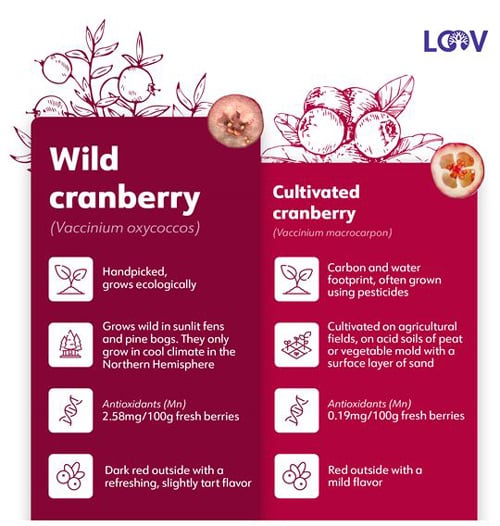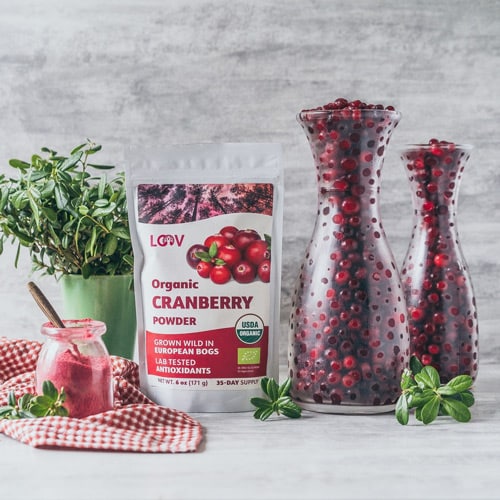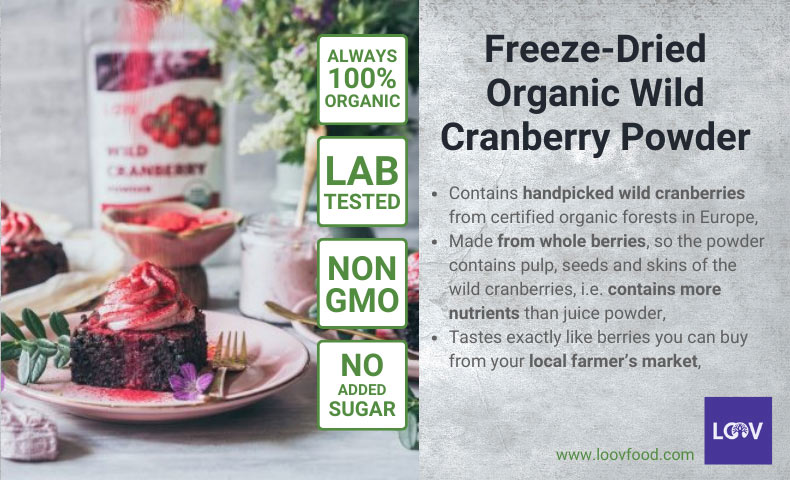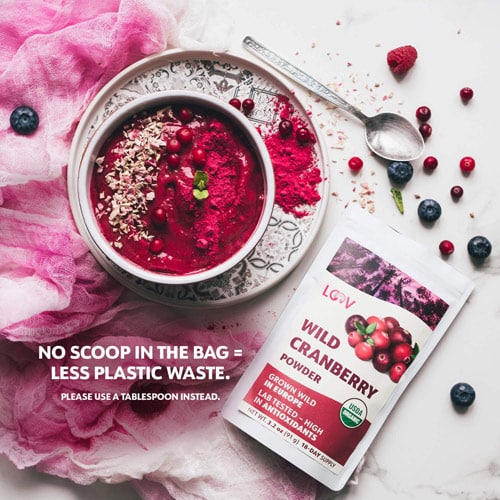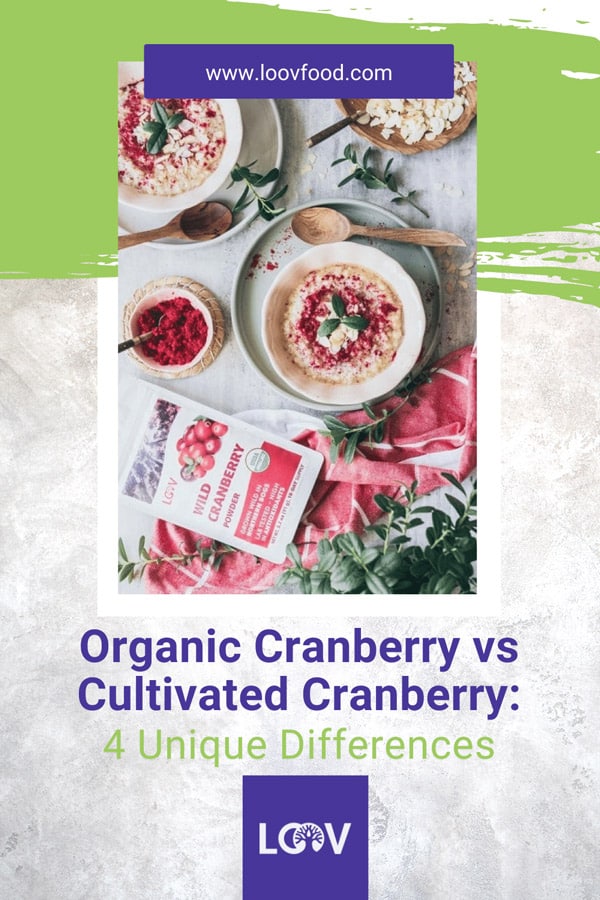It can be difficult for the average consumer to tell organic cranberries apart from cultivated ones. Most people don’t even realise there’s a difference.
This really isn’t that big of a surprise—not only do these berries share a name, but they also have a distinctive tart flavour. Additionally, the evergreen shrubs on which they grow are much alike to the untrained eye.
Table of Contents
1. What’s the Difference Between Organic and Cultivated Cranberries?
2. Organic Cranberries Have Higher Levels of Antioxidants
3. Organic Wild Cranberries Are a Superfood
4. Cultivated Cranberries Have Potent Endocrine Disruptors
5. Cultivated Cranberries Have a High Dietary Risk
6. LOOV Food Freeze-Dried Organic Wild Cranberry Powder
7. Discover LOOV Food
But why should you care about the differences between the two? Well, despite their similarities, organic and cultivated cranberries have different nutritional profiles.
Additionally, their growing technique can imbue them with qualities you may or may not want in your food.
Today, we explore the unique differences between these two kinds of cranberries, including:
What’s the Difference Between Organic and Cultivated Cranberries?
Organic cranberries are scientifically recognised as Vaccinium oxycoccos.
They grow wild in the mountainside seeps of the Nordic region, “half buried in Sphagnum hummocks of bogs at low to middle elevations, and wet subalpine meadows,” as described by Pojar and Mackinnon.
Organic wild cranberries are significantly smaller—typically about half the size of those you’d find in your local supermarket—and famously very tart thanks to their low sugar content.
Cultivated cranberries, on the other hand, are native to North America, where they’ve been consumed for thousands of years.
There are different cultivated varieties, but the most common cultivar is Vaccinium macrocarpon, which is favoured because of its large fruits. It’s the variety you’re most likely to find in Thanksgiving cranberry sauce, wine, juices and baked goods.
But these qualities aren’t all that set organic and cultivated cranberries apart.
1. Organic Cranberries Have Higher Levels of Antioxidants
Organic wild-grown cranberries have more antioxidants than their cultivated counterparts. This is evidenced by the dark red skin and tart flavour of organic cranberries, which indicates a much higher concentration of the antioxidant anthocyanin.
In contrast, the lighter red skin and milder flavour of cultivated cranberries indicate lower levels of anthocyanin.
Furthermore, while both varieties are packed with nutrients, organic wild cranberries have higher concentrations of vitamins, minerals and other nutrients.
2. Organic Wild Cranberries Are a Superfood
Organic wild cranberries contain exceptionally high amounts of bioactive plant compounds and antioxidants, especially:
- Flavanol polyphenols, like myricetin
- A-type proanthocyanidins
- Vitamins C, K and E
- Manganese
This is mainly a result of their adaptation to their natural habitat and organic growing conditions.
Consider this: the Nordic region sees only three months of sunshine annually. This short window of warmth and growth forces native plants, such as wild cranberries, to store energy and nutrients in order to survive the long, harsh Nordic winters.
Additionally, Nordic regions (including Estonia and Finland, where we pick our wild cranberries) boast some of the purest air and cleanest waters in the world.
These conditions come together to create berries that are bursting with nature’s goodness and flavour!
At LOOV Food, we bring you handpicked, organic wild cranberries from Scandinavian forests. Unlike cultivated cranberries, our berries are highly nutritious and ecologically produced.
“This is exactly what you’d expect of a powdered, freeze-dried fruit: a perfectly desiccated powder that dissolves easily in liquids and makes an excellent season for things like oatmeal and plain yoghurt …”
– CJ, Verified Buyer
💡 Expert Tip:
Supplement your organic cranberry intake with Astaxanthin
Since we’re talking superfoods, we’d be remiss not to mention astaxanthin—one of nature’s most potent antioxidants.
Astaxanthin is 6000 times stronger than vitamin C and has a myriad of health benefits, including the support of heart, eye, joint and skin health. It further helps maintain a strong immune system and normal brain function.
3. Cultivated Cranberries Have Potent Endocrine Disruptors
One of the most prevalent chemicals applied to cultivated cranberries is chlorpyrifos. This is a potent insecticide, acaricide and miticide used to control foliage and soil-borne insect pests.
However, chlorpyrifos poses some significant health and environmental hazards.
When ingested, chlorpyrifos is broken down into a toxin known as chlorpyrifos oxon, a known endocrine disruptor associated with poisoning—even in “safe” amounts.
In the environment, chlorpyrifos is highly toxic to many bird species, fish and aquatic invertebrates, bees and other small animals.
4. Cultivated Cranberries Have a High Dietary Risk
In a report published by The Organic Centre, cultivated cranberries were shown to have a high dietary risk index score because of the number of chemicals used in their cultivation and the toxicity of those chemicals.
In part, this happens because exceptions are sometimes made to agricultural laws. In areas where cranberries are a significant contributor to the economy, such as Massachusetts (a leading global producer of cranberries), exceptions are granted to farmers to use various agricultural chemicals to support their crops.
As such, cultivated cranberries are often laced with harmful chemicals from pesticides and fertilisers.
This table showcases several common toxic chemicals found in cultivated cranberries and their toxicities.
| Chemical | % Of Occurrence In Cultivated Cranberries | Toxicity |
| Chlorothalonil | 56.6% | Known to cause neoplasm |
| 1-Naphthol | 47.6% | Hormone disruptor |
| Acephate | 25.0% | Hormone disruptor Causes neoplasm Neurotoxin |
| Chlorpyrifos | 22.5% | Hormone disruptor Neurotoxin Bee toxin |
| Methamidophos | 15.5% | Neurotoxin Bee toxin |
Information from the USDA Pesticide Data Program (PDP)
Note: Organic cranberries contain none of these chemicals since they grow naturally in protected wild bogs
💡 Expert Tip:
Know the difference between lingonberries and cranberries.To the untrained eye, lingonberries and cranberries can be challenging to tell apart. Both berries look similar and have a sour flavour.
However, lingonberries and cranberries are not the same. Lingonberries (Vaccinium vitis-idaea) grow in the boreal forests of the northern hemisphere, while cranberries thrive in Nordic bogs.
See Also: Lingonberries vs. Cranberries: Differences and Health Benefits
LOOV Food Freeze-Dried Organic Wild Cranberry Powder
LOOV’s Freeze-Dried Organic Wild Cranberry Powder is a tart, tangy powder made from hand-picked wild cranberries from the pristine forests of Europe.
We produce our cranberry powder using a freeze-drying process that helps preserve all the nutritional content of our organic berries.
Our Organic Wild Cranberry Powder contains all the nutrients of fresh cranberries and even more antioxidants.
Unlike other cranberry powder manufacturers, LOOV Food’s cranberry powder contains no added sugars to offset the fruit’s natural tartness.
We appreciate that many of the cranberry fruits’ beneficial compounds are concentrated in the skin. This is why we use the whole berry when making our cranberry powder.
We also go one step further and lab-test our products to ensure the highest nutritional value and quality.
“So far, this is my favourite. I love the taste and energy of it, and I guess my body must need what wild cranberries offer. I must have some of this daily…”
– Kinbria F., Ireland
Discover LOOV Food
In 2008, two lifelong friends, Kristjan and Ahto, brewed organic, wild blackcurrant and blueberry mulled wine for the annual Tallinn Town Hall Square Christmas market. It was a smashing success.
The spicy tincture of ancient Estonian forest magic inspired Kristjan and Ahto to create LOOV Food. With this company, they could share the unique flavours and powerful nutrition of the Nordic forests with the world.
Since its inception, LOOV Food has operated by the same values that stood behind its first elixir (the mulled wine that started it all):
- All products are 100% organic
- No fillers or preservatives
- Free from genetically modified organisms or added sugars
Furthermore, we lab-test every batch of our handpicked wild berries to ensure they’re of the highest quality.
This, combined with our freeze-drying production process, helps preserve not just the nutrients but also the colour and taste of the berries.
Visit our online store today to discover our selection of organic wild superfoods plucked from magical Nordic forests.
Share on Pinterest:
